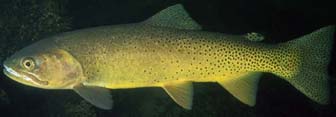Idaho State University fisheries scientists study effects of global warming on trout; young fish could be susceptible
April 1, 2010
Fisheries researchers at Idaho State University modeled the effects of global climate change on cutthroat trout, concluding that warming water temperatures would adversely affect yearling fish.
Ernest Keeley, ISU professor of biological sciences director of the ISU Fish Ecology Laboratory, and ISU master’s student Amy Jenkins, recently published a study that predicts that if water temperatures in Rocky Mountain streams increase by 1 to 6 degrees Celsius that smaller, juvenile fish that will be at risk. Keeley and Jenkins studied Yellowstone cutthroat trout in Burns Canyon Creek, a tributary of the South Fork of the Snake River in East Idaho.
 “Our study attempts to estimate what will happened to these cutthroat trout if the fish experience warmer temperatures during the normal growing season,” Keeley said.
“Our study attempts to estimate what will happened to these cutthroat trout if the fish experience warmer temperatures during the normal growing season,” Keeley said.
“Warmer water temperatures will have a mixed effect. We found that larger fish will actually do better and smaller fish will do worse. The weak link in the chain for the lifecycle of cutthroat trout experiencing warmer water is the smaller fish, in their first year of life.”
As fish and most animals grow larger their metabolisms slow down, so they require less energy in relation to their body weight to grow. Small fish have to consume energy at a lot higher rate than do older fish. Since fish are ectothermic, or organisms that control body temperature through external means, warmer water temperatures require them to burn energy at a higher rate, putting stress on the fish.
 Keeley and Jenkins modeled temperature gains of 1 to 6 degrees. Even at the lower end of the spectrum, at a 1- and 2-degree increase, the smaller fish were adversely affected. Most climate models predict an increase in water temperatures of 3 to 6 degrees, and there were much larger changes modeled at the higher end of this temperature spectrum.
Keeley and Jenkins modeled temperature gains of 1 to 6 degrees. Even at the lower end of the spectrum, at a 1- and 2-degree increase, the smaller fish were adversely affected. Most climate models predict an increase in water temperatures of 3 to 6 degrees, and there were much larger changes modeled at the higher end of this temperature spectrum.
“Model simulations indicated that climate change might reduce habitat quality for small-bodied trout, while extending the growing season for larger fish,” Keeley said. “Increased food abundance provided only marginal changes to model outcomes, whereas reductions in food significantly reduced habitat quality.”
The scientific paper referenced in this story was titled “Bioenergetic assessment of habitat quality for stream-dwelling cutthroat trout (Oncorhynchus clarkii bouvieri) with implications for climate change and nutrient supplementation” and it appeared in the February edition of the Canadian Journal of Fisheries and Aquatic Sciences (http://pubs.nrc-cnrc.gc.ca/rp-ps/journalDetail.jsp?jcode=cjfas&lang=eng).
“Global climate change will have many impacts on organisms and we’re just starting to get a handle on that,” Keeley said. “
This research was supported by funds from the Graduate Student Research Committee of Idaho State University and the Union Pacific Railroad Foundation.
###
About Idaho State University
Idaho State University, a Carnegie-classified doctoral research institution founded in 1901, educates approximately 14,000 students per year in more than 280 programs. It is Idaho’s lead institution in health professions and medical education. Its seven colleges engage in a broad range of innovative research, teaching, and learning in the natural and physical sciences, humanities, performing and visual arts, education, engineering, business, pharmacy, and technology. Visit ISU today at www.isu.edu.
Categories:
